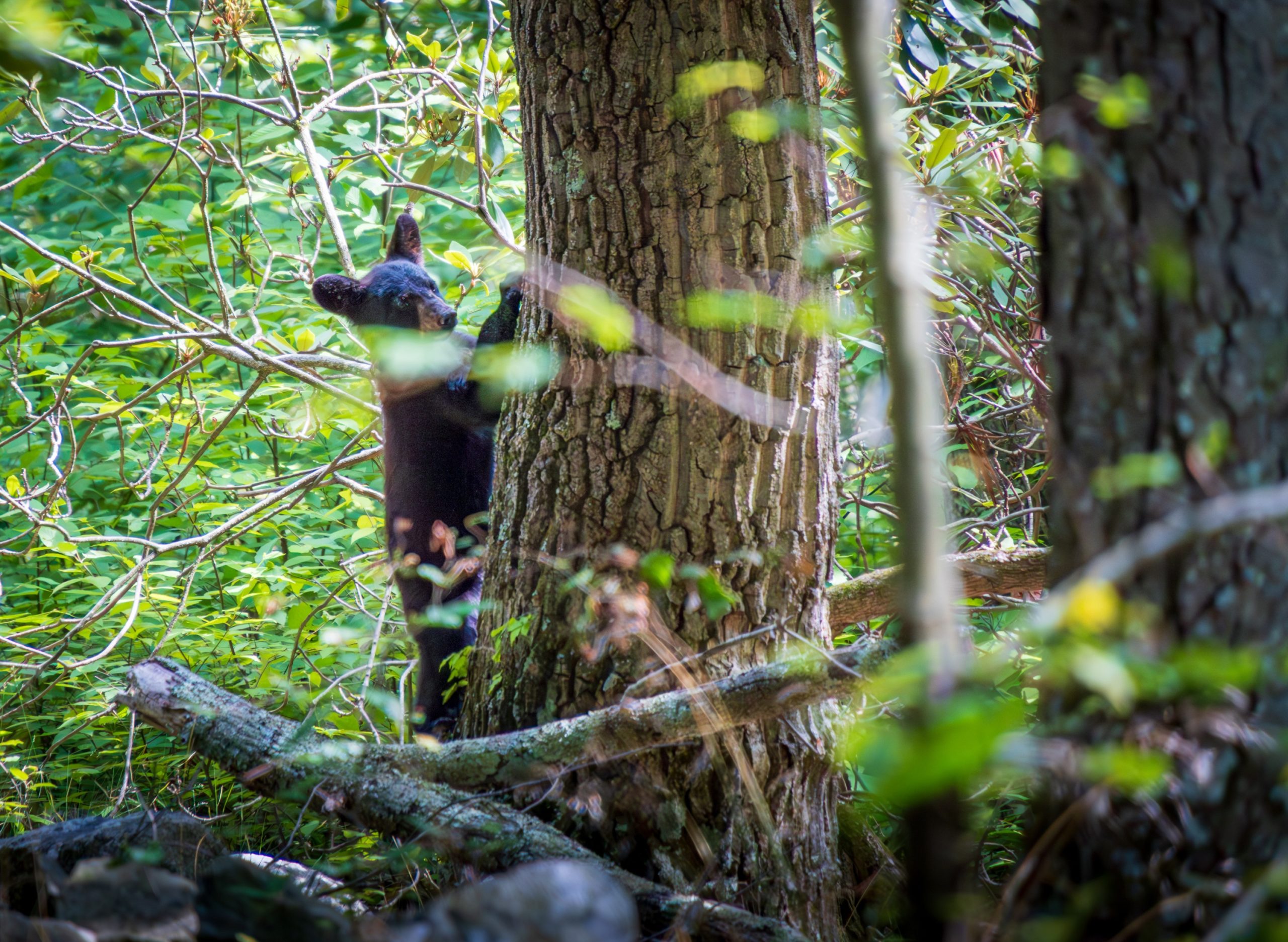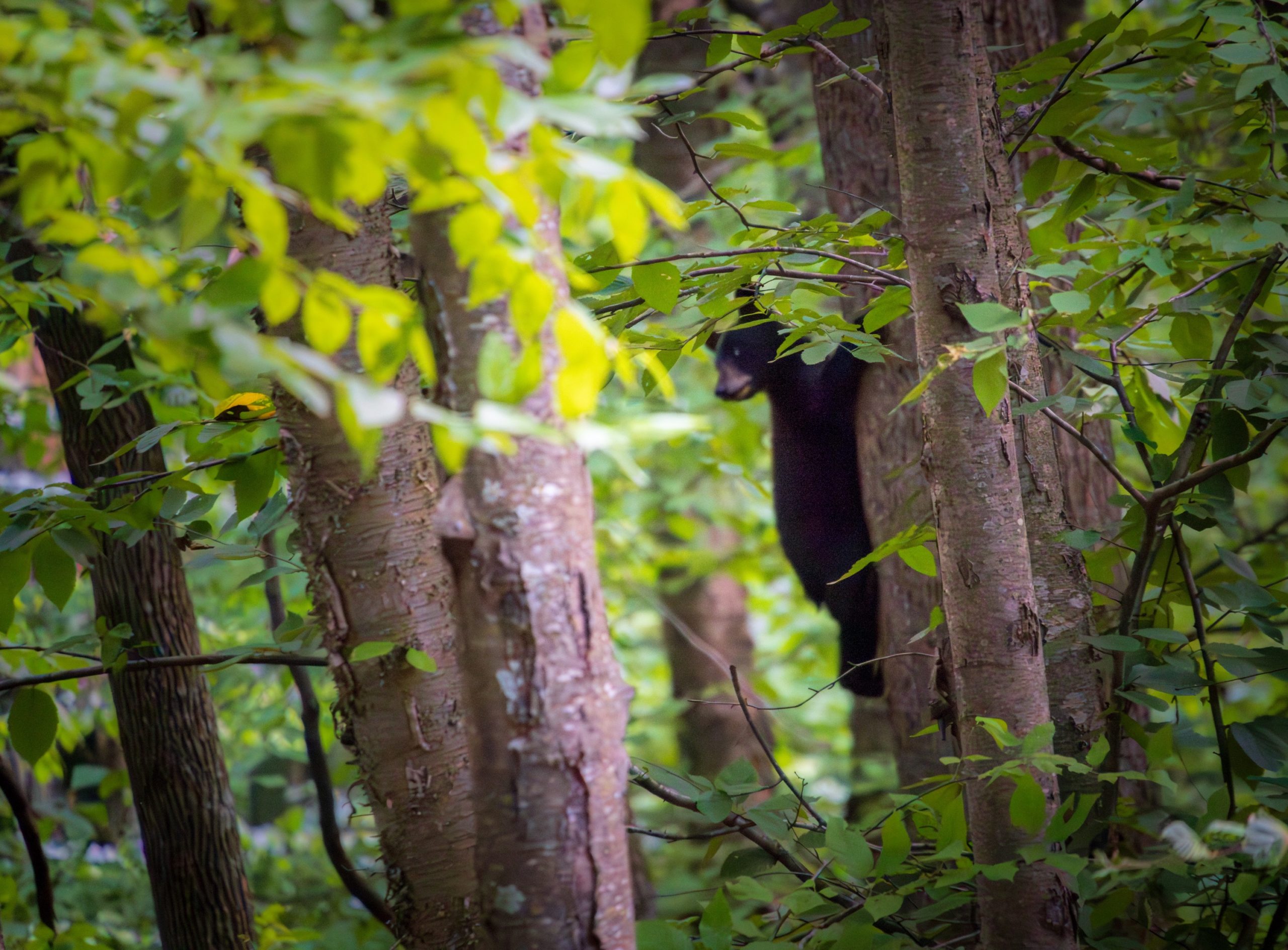We had just finished a day of repainting the famous 2″ by 6″ white blazes on my adopted section of the Appalachian Trail in Worthington State Forest. We were in dense woods about a half mile from the trailhead when we saw him: A black bear about 50 to 100 feet ahead, off to the right side of the trail, next to a stream. I did what you’re supposed to do when you encounter a bear – I reached for my camera.
But I was too slow. He had already taken off, darting across the trail ahead of us and scampering into the woods to our left, away from the stream.
For someone who spends a lot of time outdoors, I haven’t seen many bears in the woods. In fact, this was only the third time, and two of those times I missed my chance to photograph them.
He’s not a he
My disappointment turned to excitement when we noticed two bear cubs start to run in the same direction. We quickly realized that the bear that ran off wasn’t a he – that was a mama bear we had seen.
We had encountered a mother bear with her cubs – the most feared thing in the woods – and she high-tailed it and left the cubs on their own. Despite the misconceptions about the aggressive mama bear defending her cubs, that is a grizzly bear trait, and what we had witnessed is incredibly normal behavior for black bears – but we’ll come back to that in a minute.
For now, we were focused on the cubs who were making their way towards a large tree. The first cub quickly started to climb. It practically ran up the tree.

Its smaller sibling followed after the first one, scampering into the woods and making its way up the same tree. Unfortunately I wasn’t fast enough and all my photos of the cubs running and climbing are pretty blurry.


This video shows just how quickly they were able to run up the tree.
It was one of the larger trees in the area, and they must have climbed up 100 feet or more. Thanks to the reach of my 300mm zoom lens, I was able to capture decent photos of the cubs perched high above and looking down at us from the branches at the top.


While we enjoyed witnessing the cubs climb and look down at us, we assumed that the mother bear was probably not too far off, likely keeping an eye on us, even if we couldn’t see her. We didn’t stick around for long and kept walking back to the trailhead.
Black bear behavior

And as it turns out, the behavior we saw from the mom and cubs is typical behavior for black bears. They are, in fact, very different in their behavior compared to grizzly bears.
One of the reasons that I was so excited to see the bears rather than panicked with fear of running into a sow with cubs is thanks to the book “Bear Attacks – Their Causes and Avoidance” by Stephen Herrero. This book is the bible of bear behavior and is considered the landmark study on attacks by grizzly and black bears.
I highly recommend it to anyone who spends time outdoors, but I’ll share a few excerpts that highlight the differences between grizzly bears and less aggressive black bears (which are the only kind of bear on the east coast), especially when it comes to mother bears with their cubs.
“Sudden encounters with black bears, even mothers with cubs, seldom lead to injury—further evidence of the bears’ tolerance for human beings. In a sudden encounter the black bear’s behavior is different from the grizzly’s.”
Bear Attacks, pp.94
The mother bear’s scampering off was literally textbook behavior:
Researchers studying black bears confirm that black bear females are seldom aggressive, even when harassed….Al Erickson, who made the pioneer study of black bears in North America…stated that contrary to the popular belief at the time:
Most female bears did not display strong maternal protective instinct, and quickly abandoned cubs when danger was imminent.
Bear Attacks, pp. 96
And same for the cubs:
“I have observed that young black bears readily climb trees when startled….Black bear cubs require no signal from their mothers to climb a tree when potential danger appears.”
Bear Attacks, pp. 209
This makes it seem like mother black bears lack maternal instincts.
But certainly the black bear mother defends her cubs – or does she? The answer is a qualified yes. The mother’s response when threatened with potential danger will be to flee with the offspring, to climb a tree with them, or to stay on the ground and direct aggressive actions toward the intruder while the cubs find shelter up a tree or in dense vegetation….
How then does the mother black bear protect her cubs? The cubs actually protect themselves either by going into dense cover or more commonly by climbing high trees, often going to near the top of trees fifty to one hundred feet tall or higher, and then occasionally climbing out onto fairly small limbs….
The mother bear normally either climbs into the tree with the clubs or stays nearby on the ground and directs threats toward the potential source of danger.
Bear Attacks, pp. 210
Certainly, black bears can express aggressive behavior – typically up to bluff charges – but they rarely result in death. I encourage reading the book to understand what those aggressive behaviors look like (and importantly, why), and understand the rare situations in which black bears exhibit predatory behavior towards humans, which you should take extremely seriously and fight back.
The evolution of aggression in female bears
One of the most fascinating and helpful aspects of the book is how it explains the evolutionary origins for the black bear’s behavior of running from threats and climbing trees compared to the (understatement) grizzly bear’s more aggressive behavior. Or as better described by Andy Russell and recounted in Bear Attacks: “To compare him [the grizzly] with his lesser cousin, the black bear, is like standing a case of dynamite beside a sack of goose feathers.”
The author’s theory is that the different environments under which the two species evolved explains the significant difference in behaviors. Black bears, which primarily inhabit forests, evolved a strategy of bluffing.
Black bear mothers are great bluffers. Charges, paw swats, huffing, and snorting are some of the aggressive gestures and sounds that they direct toward intruders. They display weapons such as teeth and claws. Displays, threats, and warning sounds also happen very fast, giving an element of surprise. But contact and injury seldom follow. I developed the hypothesis that this type of defense evolved because the mothers that used it often were able to chase away potential sources of danger without resorting to combat. Because combat could lead to injury of the mother bear, and the cubs could be protected without combat, black bear females with cubs evolved a strategy of bluffing….
In this context it is easy to see the importance to black bears of trees and other escape terrain such as dense brush. Trees or dense brush are at the core of the mother bear’s defense of offspring….No wonder the black bear ventures from the forest reluctantly.”
Bear Attacks, pp. 214
On the other hand, Herrero outlines his hypothesis for how grizzly bears – due to the absence of forests in their environment – evolved to be more aggressive than black bears in order to defend their young.
To understand why requires a journey back in time for several million years, to the age when the grizzly bear first evolved. A dynamic environment existed then. Great sheets of ice advanced and retreated at least four times over the several millions years of the Pleistocene Epoch. The retreating glaciers are thought to have left behind extensive treeless plant communities in highly productive early stages of succession. There was abundant, high-quality vegetation for a bear to eat. In addition, there were many other grazers and browsers utilizing the glacial edge environment. For a bear this meant occasional prey as we as carcasses of dead animals to scavenge. There was one problem for bears: The black bears that existed in North America and Asia probably needed the forest for reasons of safety.
I suggest that grizzly bears evolved from forest-dwelling ancestors by developing adaptations that allowed them to feed and survive in the open environments created by glacial retreat. I have described how natural selection favored longer claws and greater development of muscles related to digging for food. Natural selection also favored females that could effectively defend their cubs in a treeless environment. Here the cubs could not provide for their own protection by climbing out of harm’s way. The female had to repel potential predators, and these certainly existed. Wolves were numerous, and large cats, such as the saber-toothed, were present. Other bears were threats as well, and the cubs lacked the safety of trees.
I hypothesize that natural selection favored aggressive female grizzly bears. When the cubs were on the ground, predators might have been persistent to the point that the mother bear would resort to attack after threats failed to remove the danger. I suspect that even here, contact with animals that represented danger was the exception. This would have been true because of the previously mentioned dangers to mother bears in such circumstances. When, however, potential sources of danger suddenly appeared at close range, the threat may have been a trigger for action. Whatever the circumstances were, the grizzly bear mother evolved as a bear more likely than was the black bear mother to physically attack some potential sources of danger. Humans seem to fit into this category.
Thus the grizzly bear developed structures and behaviors that allowed it to eat the more-abundant foods of open environments, and while in the open, to defend itself and its cubs.
Bear Attacks, pp. 215-16
Hopefully, this helps to not only dispel some of the myths about bears, but also to ease fears about being in the outdoors.
And next time you’re in black bear territory and find yourself between a mama bear and her cubs, you won’t panic because you read Bear Attacks, you’ll recognize their behavior, and you’ll know exactly what to do to stay safe. And then you’ll reach for your camera.